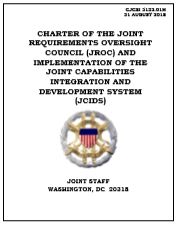 The Joint Capabilities Integration and Development System (JCIDS) process is one of three (3) processes (Acquisition, Requirements, and Funding) that support the Defense Acquisition System. It was created to support the statutory responsibility of the Joint Requirements Oversight Council (JROC) to validate joint warfighting requirements. It plays a key role in identifying the capabilities required by the warfighters to support the National Defense Strategy (NDS), the National Military Strategy (NMS), and the National Strategy for Homeland Defense. [1]
The Joint Capabilities Integration and Development System (JCIDS) process is one of three (3) processes (Acquisition, Requirements, and Funding) that support the Defense Acquisition System. It was created to support the statutory responsibility of the Joint Requirements Oversight Council (JROC) to validate joint warfighting requirements. It plays a key role in identifying the capabilities required by the warfighters to support the National Defense Strategy (NDS), the National Military Strategy (NMS), and the National Strategy for Homeland Defense. [1]
Purpose of the JCIDS Process
The purpose of the JCIDS process is to provide the baseline for documentation, review, and validation of capability requirements across the Department of Defense (DoD).
Objective of the JCIDS Process
The primary objective of the JCIDS process is to ensure the capabilities required by the joint warfighter are identified, along with their associated operational performance criteria (requirements), in order to successfully execute the missions assigned. This is done through an open process that provides the JROC with the information needed and supports the Defense Acquisition Process and Planning, Programming, Budget, and Execution (PPBE) Process.
JCIDS Process Key References
Flow Chart: JCIDS Process Flow Chart (Outdated)
Instruction: CJCSI 5123.01I “Charter of the JROC and Implementation of the JCIDS” – Oct 2021
Manual: Operations of the Joint Capabilities Integration and Development System (JCIDS)
Combined JCIDS and Acquisition Process
The JCIDS process supports the Acquisition Process by identifying and assessing capability needs and associated performance criteria. A depiction of the relationship between the JCIDS process and key acquisition process decision points (Milestones and Phases) is shown in the figure below. [1]

Joint Capabilities Integration and Development System (JCIDS) Process Steps
Step 1: Conduct a Capabilities Base Assessment (CBA)
When a Service or Agency wants to start the JCIDS process with a new method or a capability that will change things, they will do a capabilities-based analysis (CBA), a DOTmLPF-P analysis, or other studies or analyses of quickly fielded capability solutions. The objective of the CBA and other studies is to validate capability gap(s) by providing: [1]
- Identification of the mission;
- The capabilities required and their associated operational characteristics and attributes;
- Capability gaps and associated operational risks;
- Assessment of the viability of a non-material solution;
- Potential recommendation on a type of solution to be pursued.
Results
- – If a materiel solution is proposed, an Initial Capabilities Document (ICD) is developed.
- – If a non-material solution is proposed, a (DOTMLPF) Change Recommendation (DCR) is produced.
Step 2: Approval of the Initial Capabilities Document (ICD) and Courses of Action
When the JROC approves an ICD, it validates the capabilities required to perform the mission as defined; the gap in capabilities along with their priorities and operational risks; and the need to address the capability gaps. The JROC may direct three (3) courses of action to address capability gaps: [1]
- Accept operational risk and take no further action;
- Seek a non-material approach (changes to doctrine, organization, etc.) to address the capability gap as an alternative or adjunct to a new material solution;
- Recommend a material solution.
Step 3: Approval of the Capability Development Document (CDD)
In approving the CDD, the JROC: validates the Key Performance Parameters (KPP) and their associated threshold and objective values; assesses the risks in meeting those KPPs in terms of cost, schedule, and technological maturity; and assesses the affordability of the system as compared to the operational capability being delivered. The JROC may consider alternatives to any acquisition program by evaluating the program’s cost, schedule, and performance criteria and identifying alternatives. [1]
Joint Requirements Oversight Council (JROC)
The Joint Requirements Oversight Council (JROC) charters and oversees the work in developing overarching joint operational and integrating concepts for joint missions during the joint concept development component of the JCIDS Process. The JROC reviews and approves all joint capabilities documents designated as JROC interest and supports the acquisition review process.
The JROC validates capability needs and Key Performance Parameters (KPP) along with their associated threshold and objectives when it approves the associated capabilities documents; (Initial Capabilities Documents (ICD), Capability Development Documents (CPD), and Capability Production Documents (CPD)).
 Main JCIDS Instruction
Main JCIDS Instruction
The new Chairman of the Joint Chiefs of Staff Instruction (CJCSI) 5123.01I “Charter Joint Requirements Oversight Council (JROC) and Implementation of the Joint Capabilities Integration and Development System (JCIDS) replaces the CJCSI 31070.01.
History of the DoD Requirements System
The requirements generation system, which had been in use since 1991, was superseded by the JCIDS when it was founded in June 2003. In 2003, terms related to interoperability and integrated architectures—a concept that is now gaining traction—started to surface. CJCSI 5123.01I Charter of the Joint Requirements Oversight Council (JROC) and Implementation of the Joint Capabilities Integration and Development System was reissued with an accompanying Manual for the Operation of the Joint Capabilities Integration and Development System. These changes aim to clarify further and simplify the system.
AcqLinks and Resources:
- [1] CJCSI 5123.01I “Charter of the Joint Requirements Oversight Council (JROC) and Implementation of the JCIDS” – 30 Oct 2021
- [Old] CJCSI 5123.01H “Charter of the Joint Requirements Oversight Council (JROC) and Implementation of the JCIDS” – 31 Aug 2018
- [Old] CJCS Instruction 3170.01 “Joint Capabilities Integration and Development System (JCIDS)”
- Manual for the Operations of the Joint Capabilities Integration and Development System (JCIDS)
- Defense Acquisition Guidebook (DAG) – Chapter 1
- (Outdated) JCIDS Process Flow Chart
- Website: JCIDS Intellipedia (CAC Required)
- Website: DAU JCIDS Portal
Updated: 2/10/2024
Rank: G1
